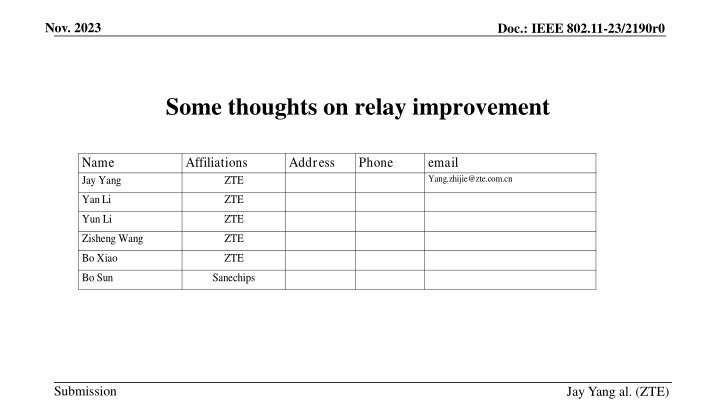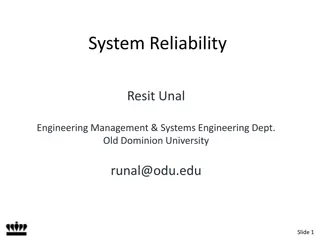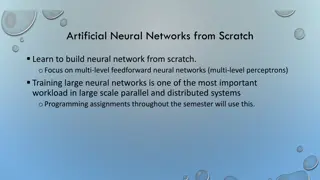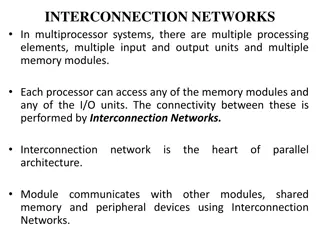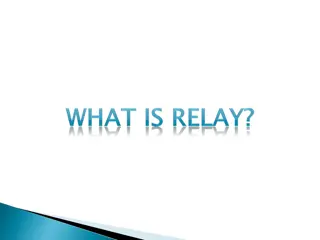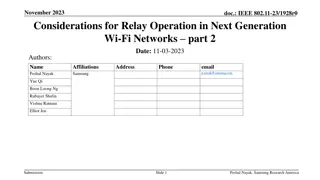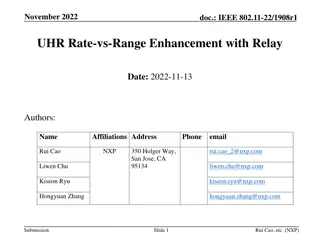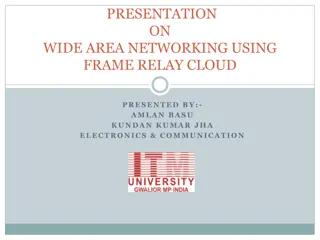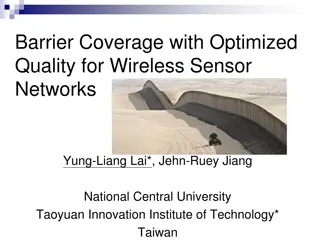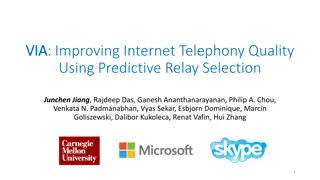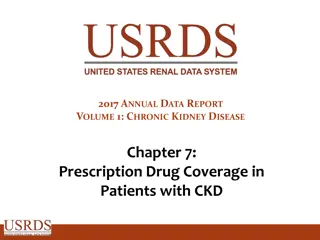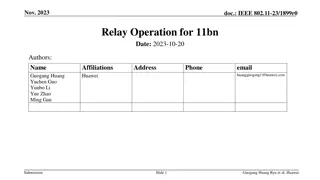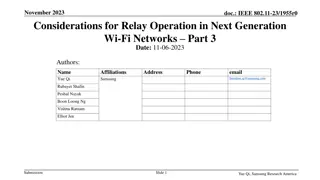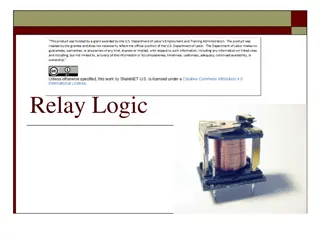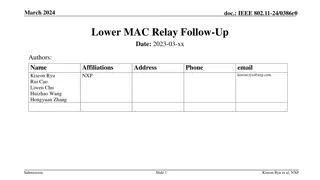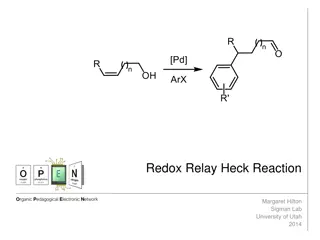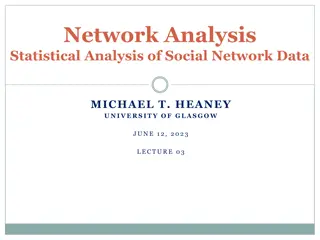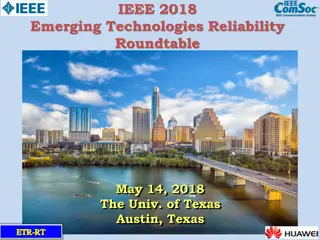Enhancing Wi-Fi Relay Networks for Improved Coverage and Reliability
This document discusses the need to enhance relay frameworks in Wi-Fi networks to improve coverage, reliability, and performance of stations in different ranges. It highlights the challenges of S1G-based relays, proposes enhancements to the relay framework, and introduces new types of relay frameworks like FTTR and RIS. The shortcomings of S1G-based relays in terms of higher delay and lower reliability are also addressed, emphasizing the impact on packet loss and retransmission delays. Suggestions to mitigate these issues are presented to enhance the overall efficiency of Wi-Fi relay networks.
Download Presentation

Please find below an Image/Link to download the presentation.
The content on the website is provided AS IS for your information and personal use only. It may not be sold, licensed, or shared on other websites without obtaining consent from the author.If you encounter any issues during the download, it is possible that the publisher has removed the file from their server.
You are allowed to download the files provided on this website for personal or commercial use, subject to the condition that they are used lawfully. All files are the property of their respective owners.
The content on the website is provided AS IS for your information and personal use only. It may not be sold, licensed, or shared on other websites without obtaining consent from the author.
E N D
Presentation Transcript
Nov. 2023 Doc.: IEEE 802.11-23/2190r0 Some thoughts on relay improvement Name Jay Yang Affiliations Address Phone email Yang.zhijie@zte.com.cn ZTE YanLi ZTE Yun Li ZTE Zisheng Wang ZTE Bo Xiao ZTE Bo Sun Sanechips Submission Jay Yang al. (ZTE)
Nov. 2023 Doc.: IEEE 802.11-23/2190r0 Background UHR PAR illustration improve the reliability of the wireless network improve the performance of STA in different range( improve SINR). Reduce the power consumption on both single AP or MAP Relay is a candidate feature to improve the Wi-Fi coverage issue based on the precondition of reliability. Meanwhile, it s encouraged to reduce the power consumption on the relay as well. Submission Slide 2 Jay Yang, et al. (ZTE)
Nov. 2023 Doc.: IEEE 802.11-23/2190r0 Abstract In this contribution, we will recap S1G relay framework, and analyze some proposals of S1G relay framework enhancement. Also, provide another two types of relay framework FTTR(fiber-to-the-room) RIS(Reconfigurable Intelligent Surface) Submission Slide 3 Jay Yang, et al. (ZTE)
Nov. 2023 Doc.: IEEE 802.11-23/2190r0 Recap S1G relay Relay framework under MLO S1G framework relay non-AP MLD To enlarge Wi-Fi signal coverage, the S1G-based relay products are widely deployed in residential environment in the past several years. Each relay has a relay STA entity that associates with a upper BSS and a relay AP entity that acts as an AP in a lower BSS. Relay STA and relay AP exchange the UL/DL MSDUs via a relay function In MLO, each Relay has a relay non-AP MLD that associates with an upper AP MLD and a relay AP MLD entity that acts as an AP MLD to serve non-AP MLDs. relay function AP MLD Each entity has a full MAC function, e.g. re(transmit) and receive MSDU separately. A STA or a non-AP MLD associate with the Root AP or Relay AP/AP MLD Submission Slide 4 Jay Yang, et al. (ZTE)
Nov. 2023 Doc.: IEEE 802.11-23/2190r0 The shortage of S1G-based relay Higher delay, lower reliability Each wireless hop may possible loss packet, assume the MSDU successful delivery rate is p%, N-hop wireless connection means the MSDU successful delivery rate may drop to (p%)n High level application has to retransmit the missing MSDU, which will cause a significant higher delay due to the higher missing rate in L2 layer In the cost-sensitive market, upper MLD/BSS(let s call backhaul) may operate on the same channel with lower MLD/BSS(let s call front haul), which cause a serious TP drop issue when the client associates with relay AP/AP MLD. In some high-end market, backhaul may operate on a separate channel from front haul to void the collision issue,but the reliability issue is still here Submission Slide 5 Jay Yang, et al. (ZTE)
Nov. 2023 Doc.: IEEE 802.11-23/2190r0 The analyze against S1G-based relay proposal S1G-based relay may enjoy the benefit of several MAP coordination schemes leverage the general MAP features like C-TDMA,C-OFDMA to mitigate the collision issue between backhaul and front haul The proposal for MPDU delivery in rSTA is interesting Such framework may reduce the reorder delay But reorder delay is NOT main factors Enhanced S1G-based network is a still unreliability network (U) (C) (U) (C) IEEE 802.1X IEEE 802.1X Controlled and Uncontrolled Port Filtering (optional) (M) Controlled and Uncontrolled Port Filtering (optional) (M) RX/TX MSDU Rate Limiting RX/TX MSDU Rate Limiting A-MSDU MSDU Flow - Transmitting A-MSDU MSDU Flow - Transmitting MSDU Flow Receiving MSDU Flow Receiving Aggregation (TX) / De-aggregation (RX) Aggregation (TX) / De-aggregation (RX) Replay Detection Per PN (optional) Replay Detection Per PN (optional) PS Defer Queuing1 (AP MLD Only) PS Defer Queuing1 (AP MLD Only) Upper MAC sublayer: tSTA/dSTA only functions Block Ack Buffering and Reordering per SN Block Ack Buffering and Reordering per SN Sequence Number Assignment Sequence Number Assignment MPDU Decryption MPDU Decryption Packet Number Assignment Packet Number Assignment Duplicate Detection per SN Duplicate Detection per SN Conclusion S1G-based relay can be deemed to an implementation that can enjoy the benefit with the general MAP coordination schemes. E2E Block Ack Scoreboarding E2E Block Ack Scoreboarding MPDU Encryption MPDU Encryption Null Null Null Null Relay Block Ack Scoreboarding Relay Block Ack Scoreboarding Null MPDU Header + CRC Creation MPDU Header + CRC Creation MPDU Header + CRC Creation Address 1 address filtering Address 1 address filtering Address 1 address filtering lower MAC sublayer: Relay functions MPDU Header + CRC Validation MPDU Header + CRC Validation MPDU Header + CRC Validation A-MPDU Aggregation A-MPDU Aggregation A-MPDU Aggregation A-MPDU De-aggregation A-MPDU De-aggregation A-MPDU De-aggregation (PHY SAP) (PHY SAP) (PHY SAP) PHY of tSTA PHY of dSTA PHY of rSTA dSTA tSTA rSTA Submission Slide 6 Jay Yang, et al. (ZTE)
Nov. 2023 Doc.: IEEE 802.11-23/2190r0 FTTR Overview Based on fibre backhaul(BH) connection,the MFU provides 2.5Gbps DL and 1Gbps UL throughput for SFUs in each room, and features low lost, low latency and high reliability. The packet lost rate in the BH is about: 10-12 The delay in the BH is about 10us-400us. The backhaul fibre is easier to deploy in/on the wall, which address the pain point of the deployment issue in residential environment. Submission Slide 7 Jay Yang, et al. (ZTE)
Nov. 2023 Doc.: IEEE 802.11-23/2190r0 RIS Overview Based on wave reflection and refraction mechanism, RIS features Low lost, Low latency, Low Power cost, Zero delay in seamless roaming and compatible with legacy STA. Low latency: wave propagation level latency delay Low lost: like extra virtual antennas to improve SNR Low Power cost: no power cost in operating mode, less power consumption when root AP exchanges control signaling with RIS Zero delay in seamless roaming: dynamically adopt the wave reflection and refraction when STA moves from one place to another Compatible with any legacy STA: no signaling design between STA and RIS. STAR:Simultaneously Transmitting and Reflecting RIS demo variety Submission Slide 8 Jay Yang, et al. (ZTE)
Nov. 2023 Doc.: IEEE 802.11-23/2190r0 Comparison on different Relay products SIG-based Relay FTTR RIS Packet lost rate High No Packet lost No Packet lost Reliability Low High High Relay delay ms-second 10-400us 0 Power consumption High High Extremely Low Seamless roaming NO only 11bn STA all legacy STA market intelligence(2023, China) On sell in retail market, but no order from ISP 10 million sets deployed in residential environment Not commercialization Submission Slide 9 Jay Yang, et al. (ZTE)
Nov. 2023 Doc.: IEEE 802.11-23/2190r0 Summary Recap S1G-based framework Analyze several proposals of S1G-based framework Introduce the current relay framework(FTTR) in residential environment Introduce the next generation of wireless relay framework(RIS) Submission Slide 10 Jay Yang, et al. (ZTE)
Nov. 2023 Doc.: IEEE 802.11-23/2190r0 THANK YOU Submission
Nov. 2023 Doc.: IEEE 802.11-23/2190r0 Reference [1]802.11bn PAR [2] ETSI GR RIS 006 V0.0.2 [3] ITU-T G.9940(G.fin-SA) High speed fibre-based in-premises transceivers system architecture [4]23-1138-Features to consider for efficient Relay operation [5]23-1146-Relaying for Low Latency Traffic in UHR [6]23-1175-UHR relay follow up Submission Slide 12 Jay Yang, et al. (ZTE)
